The Impact of Effective Communication Skills on Organisational Goals
VerifiedAdded on 2020/10/23
|8
|1886
|402
Essay
AI Summary
This essay delves into the critical role of effective communication within organizations, using Quantas and Southern China Airlines as comparative case studies. It defines organizational communication as the exchange of information, both internally and externally, and emphasizes its impact on employee coordination, productivity, and overall business success. The essay contrasts Quantas's effective communication strategies, including technology utilization, with Southern China's shortcomings, such as poor verbal and written communication. It examines key elements of effective communication, including speaking, listening, and understanding, and their influence on employee performance. Furthermore, it explores the causes of poor communication within Southern China, such as unclear objectives, poor leadership, and cultural diversity, and recommends improvements. Finally, the essay introduces the Attribution Theory by Fritz Heider, providing insights on how employees understand and react to information to improve their performance, and concludes by advocating for enhanced communication strategies to achieve organizational goals.
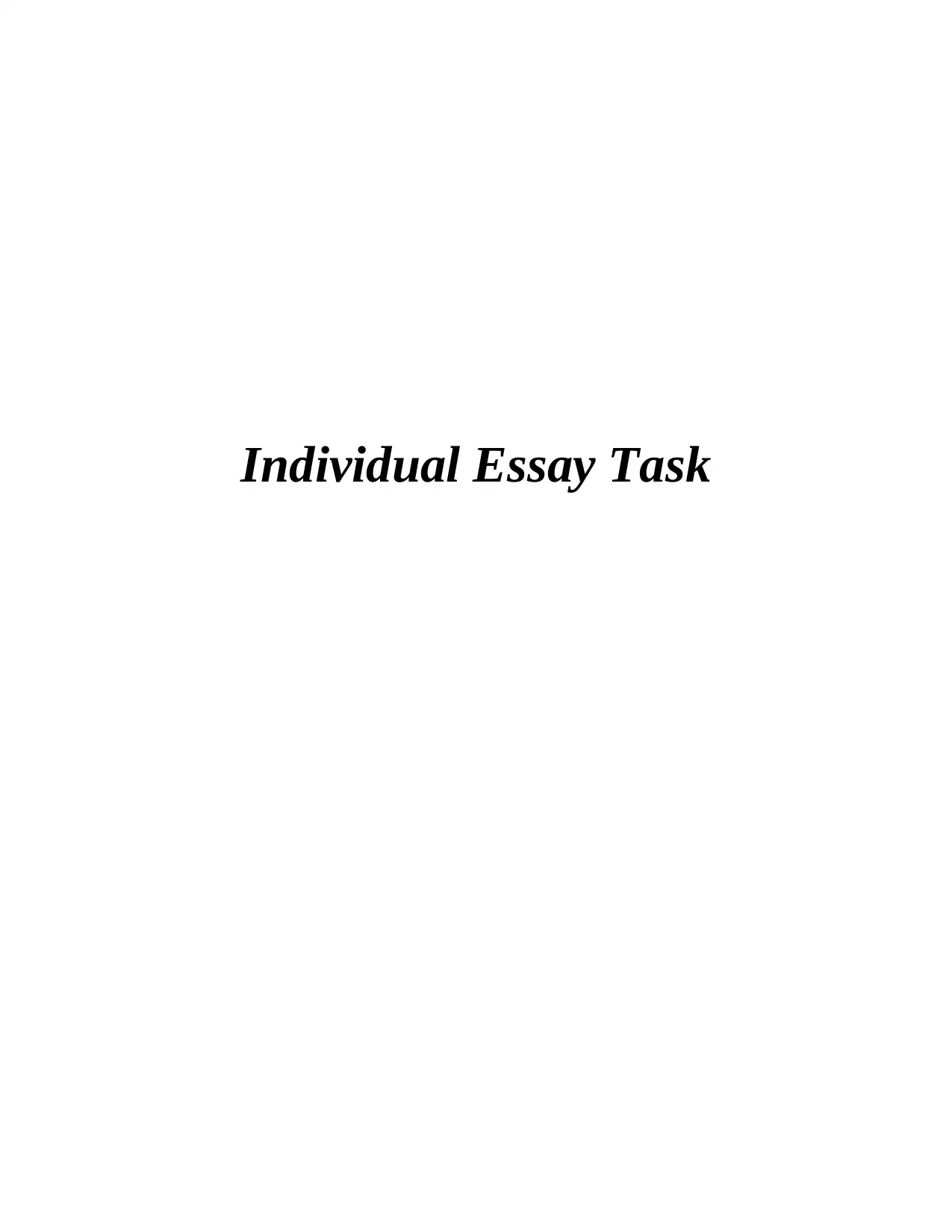
Individual Essay Task
Paraphrase This Document
Need a fresh take? Get an instant paraphrase of this document with our AI Paraphraser

Table of Contents
Organisational Communication.......................................................................................................1
REFERENCES................................................................................................................................6
Organisational Communication.......................................................................................................1
REFERENCES................................................................................................................................6
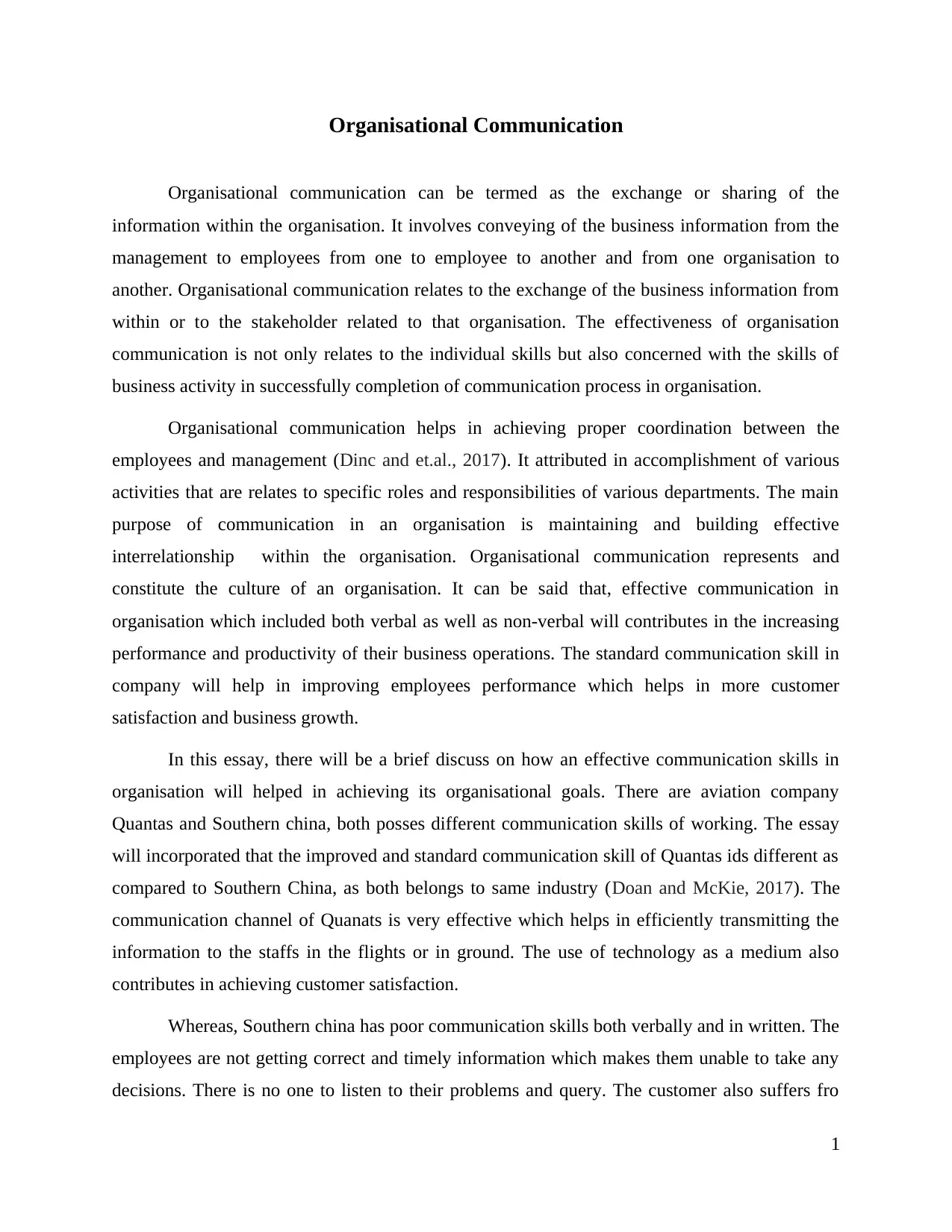
Organisational Communication
Organisational communication can be termed as the exchange or sharing of the
information within the organisation. It involves conveying of the business information from the
management to employees from one to employee to another and from one organisation to
another. Organisational communication relates to the exchange of the business information from
within or to the stakeholder related to that organisation. The effectiveness of organisation
communication is not only relates to the individual skills but also concerned with the skills of
business activity in successfully completion of communication process in organisation.
Organisational communication helps in achieving proper coordination between the
employees and management (Dinc and et.al., 2017). It attributed in accomplishment of various
activities that are relates to specific roles and responsibilities of various departments. The main
purpose of communication in an organisation is maintaining and building effective
interrelationship within the organisation. Organisational communication represents and
constitute the culture of an organisation. It can be said that, effective communication in
organisation which included both verbal as well as non-verbal will contributes in the increasing
performance and productivity of their business operations. The standard communication skill in
company will help in improving employees performance which helps in more customer
satisfaction and business growth.
In this essay, there will be a brief discuss on how an effective communication skills in
organisation will helped in achieving its organisational goals. There are aviation company
Quantas and Southern china, both posses different communication skills of working. The essay
will incorporated that the improved and standard communication skill of Quantas ids different as
compared to Southern China, as both belongs to same industry (Doan and McKie, 2017). The
communication channel of Quanats is very effective which helps in efficiently transmitting the
information to the staffs in the flights or in ground. The use of technology as a medium also
contributes in achieving customer satisfaction.
Whereas, Southern china has poor communication skills both verbally and in written. The
employees are not getting correct and timely information which makes them unable to take any
decisions. There is no one to listen to their problems and query. The customer also suffers fro
1
Organisational communication can be termed as the exchange or sharing of the
information within the organisation. It involves conveying of the business information from the
management to employees from one to employee to another and from one organisation to
another. Organisational communication relates to the exchange of the business information from
within or to the stakeholder related to that organisation. The effectiveness of organisation
communication is not only relates to the individual skills but also concerned with the skills of
business activity in successfully completion of communication process in organisation.
Organisational communication helps in achieving proper coordination between the
employees and management (Dinc and et.al., 2017). It attributed in accomplishment of various
activities that are relates to specific roles and responsibilities of various departments. The main
purpose of communication in an organisation is maintaining and building effective
interrelationship within the organisation. Organisational communication represents and
constitute the culture of an organisation. It can be said that, effective communication in
organisation which included both verbal as well as non-verbal will contributes in the increasing
performance and productivity of their business operations. The standard communication skill in
company will help in improving employees performance which helps in more customer
satisfaction and business growth.
In this essay, there will be a brief discuss on how an effective communication skills in
organisation will helped in achieving its organisational goals. There are aviation company
Quantas and Southern china, both posses different communication skills of working. The essay
will incorporated that the improved and standard communication skill of Quantas ids different as
compared to Southern China, as both belongs to same industry (Doan and McKie, 2017). The
communication channel of Quanats is very effective which helps in efficiently transmitting the
information to the staffs in the flights or in ground. The use of technology as a medium also
contributes in achieving customer satisfaction.
Whereas, Southern china has poor communication skills both verbally and in written. The
employees are not getting correct and timely information which makes them unable to take any
decisions. There is no one to listen to their problems and query. The customer also suffers fro
1
⊘ This is a preview!⊘
Do you want full access?
Subscribe today to unlock all pages.

Trusted by 1+ million students worldwide
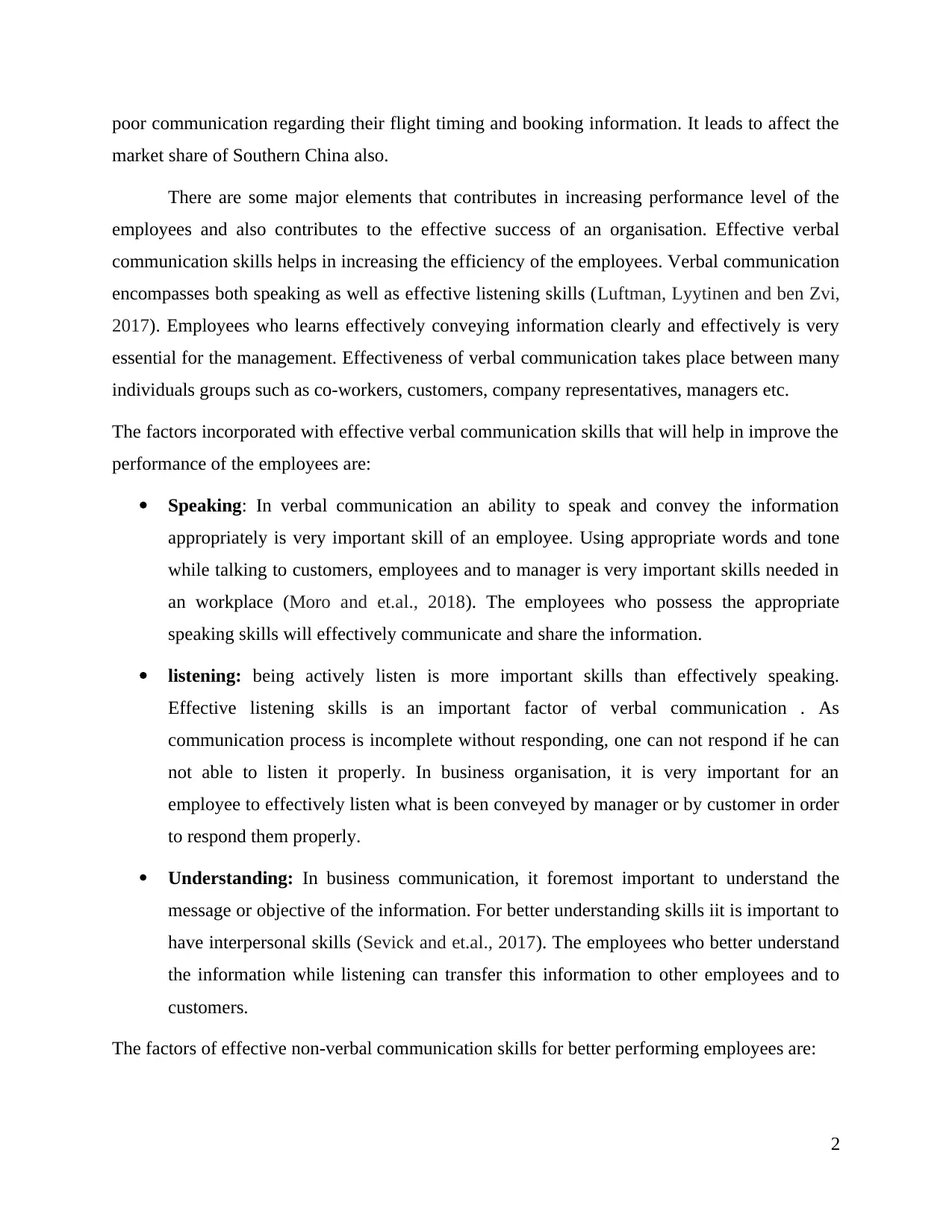
poor communication regarding their flight timing and booking information. It leads to affect the
market share of Southern China also.
There are some major elements that contributes in increasing performance level of the
employees and also contributes to the effective success of an organisation. Effective verbal
communication skills helps in increasing the efficiency of the employees. Verbal communication
encompasses both speaking as well as effective listening skills (Luftman, Lyytinen and ben Zvi,
2017). Employees who learns effectively conveying information clearly and effectively is very
essential for the management. Effectiveness of verbal communication takes place between many
individuals groups such as co-workers, customers, company representatives, managers etc.
The factors incorporated with effective verbal communication skills that will help in improve the
performance of the employees are:
Speaking: In verbal communication an ability to speak and convey the information
appropriately is very important skill of an employee. Using appropriate words and tone
while talking to customers, employees and to manager is very important skills needed in
an workplace (Moro and et.al., 2018). The employees who possess the appropriate
speaking skills will effectively communicate and share the information.
listening: being actively listen is more important skills than effectively speaking.
Effective listening skills is an important factor of verbal communication . As
communication process is incomplete without responding, one can not respond if he can
not able to listen it properly. In business organisation, it is very important for an
employee to effectively listen what is been conveyed by manager or by customer in order
to respond them properly.
Understanding: In business communication, it foremost important to understand the
message or objective of the information. For better understanding skills iit is important to
have interpersonal skills (Sevick and et.al., 2017). The employees who better understand
the information while listening can transfer this information to other employees and to
customers.
The factors of effective non-verbal communication skills for better performing employees are:
2
market share of Southern China also.
There are some major elements that contributes in increasing performance level of the
employees and also contributes to the effective success of an organisation. Effective verbal
communication skills helps in increasing the efficiency of the employees. Verbal communication
encompasses both speaking as well as effective listening skills (Luftman, Lyytinen and ben Zvi,
2017). Employees who learns effectively conveying information clearly and effectively is very
essential for the management. Effectiveness of verbal communication takes place between many
individuals groups such as co-workers, customers, company representatives, managers etc.
The factors incorporated with effective verbal communication skills that will help in improve the
performance of the employees are:
Speaking: In verbal communication an ability to speak and convey the information
appropriately is very important skill of an employee. Using appropriate words and tone
while talking to customers, employees and to manager is very important skills needed in
an workplace (Moro and et.al., 2018). The employees who possess the appropriate
speaking skills will effectively communicate and share the information.
listening: being actively listen is more important skills than effectively speaking.
Effective listening skills is an important factor of verbal communication . As
communication process is incomplete without responding, one can not respond if he can
not able to listen it properly. In business organisation, it is very important for an
employee to effectively listen what is been conveyed by manager or by customer in order
to respond them properly.
Understanding: In business communication, it foremost important to understand the
message or objective of the information. For better understanding skills iit is important to
have interpersonal skills (Sevick and et.al., 2017). The employees who better understand
the information while listening can transfer this information to other employees and to
customers.
The factors of effective non-verbal communication skills for better performing employees are:
2
Paraphrase This Document
Need a fresh take? Get an instant paraphrase of this document with our AI Paraphraser
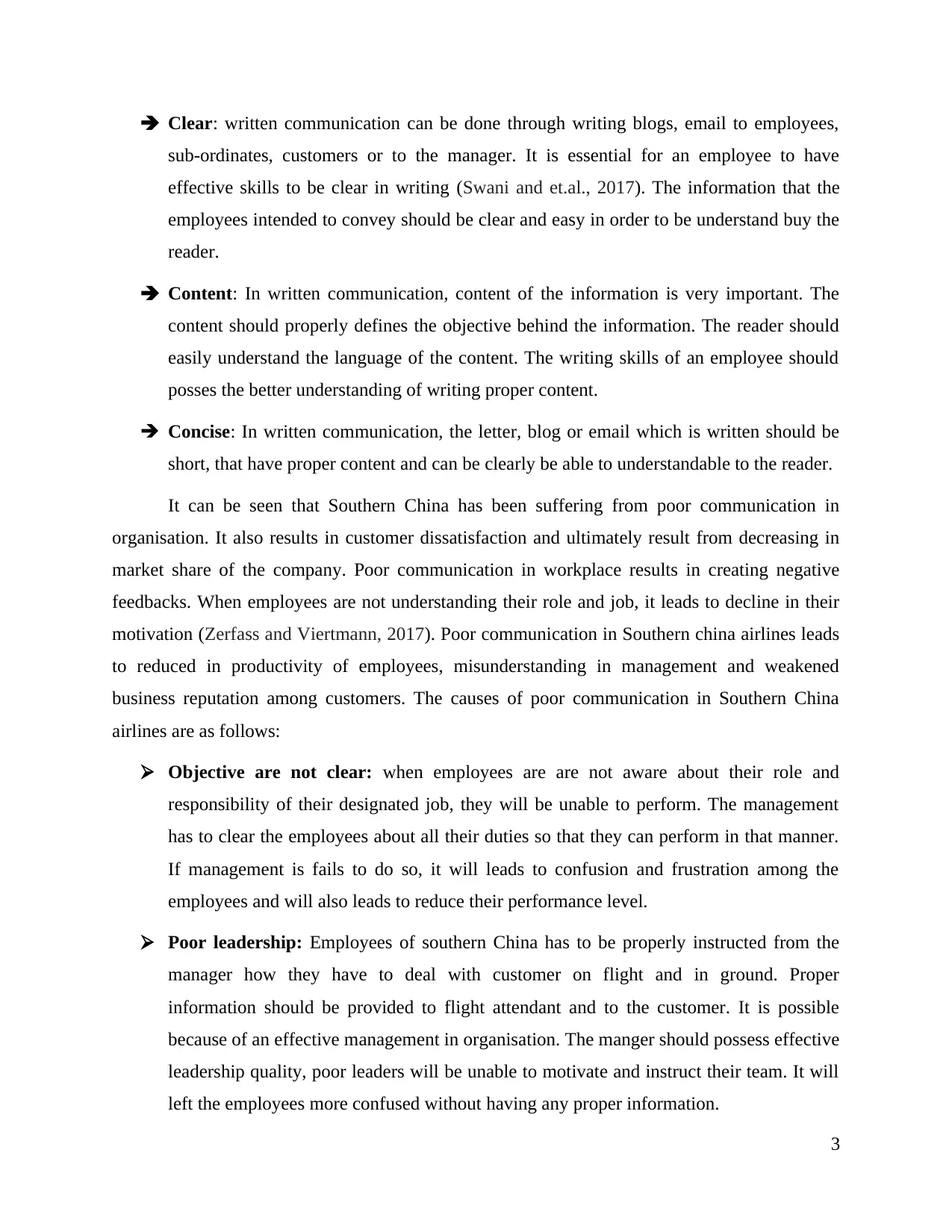
Clear: written communication can be done through writing blogs, email to employees,
sub-ordinates, customers or to the manager. It is essential for an employee to have
effective skills to be clear in writing (Swani and et.al., 2017). The information that the
employees intended to convey should be clear and easy in order to be understand buy the
reader.
Content: In written communication, content of the information is very important. The
content should properly defines the objective behind the information. The reader should
easily understand the language of the content. The writing skills of an employee should
posses the better understanding of writing proper content.
Concise: In written communication, the letter, blog or email which is written should be
short, that have proper content and can be clearly be able to understandable to the reader.
It can be seen that Southern China has been suffering from poor communication in
organisation. It also results in customer dissatisfaction and ultimately result from decreasing in
market share of the company. Poor communication in workplace results in creating negative
feedbacks. When employees are not understanding their role and job, it leads to decline in their
motivation (Zerfass and Viertmann, 2017). Poor communication in Southern china airlines leads
to reduced in productivity of employees, misunderstanding in management and weakened
business reputation among customers. The causes of poor communication in Southern China
airlines are as follows:
Objective are not clear: when employees are are not aware about their role and
responsibility of their designated job, they will be unable to perform. The management
has to clear the employees about all their duties so that they can perform in that manner.
If management is fails to do so, it will leads to confusion and frustration among the
employees and will also leads to reduce their performance level.
Poor leadership: Employees of southern China has to be properly instructed from the
manager how they have to deal with customer on flight and in ground. Proper
information should be provided to flight attendant and to the customer. It is possible
because of an effective management in organisation. The manger should possess effective
leadership quality, poor leaders will be unable to motivate and instruct their team. It will
left the employees more confused without having any proper information.
3
sub-ordinates, customers or to the manager. It is essential for an employee to have
effective skills to be clear in writing (Swani and et.al., 2017). The information that the
employees intended to convey should be clear and easy in order to be understand buy the
reader.
Content: In written communication, content of the information is very important. The
content should properly defines the objective behind the information. The reader should
easily understand the language of the content. The writing skills of an employee should
posses the better understanding of writing proper content.
Concise: In written communication, the letter, blog or email which is written should be
short, that have proper content and can be clearly be able to understandable to the reader.
It can be seen that Southern China has been suffering from poor communication in
organisation. It also results in customer dissatisfaction and ultimately result from decreasing in
market share of the company. Poor communication in workplace results in creating negative
feedbacks. When employees are not understanding their role and job, it leads to decline in their
motivation (Zerfass and Viertmann, 2017). Poor communication in Southern china airlines leads
to reduced in productivity of employees, misunderstanding in management and weakened
business reputation among customers. The causes of poor communication in Southern China
airlines are as follows:
Objective are not clear: when employees are are not aware about their role and
responsibility of their designated job, they will be unable to perform. The management
has to clear the employees about all their duties so that they can perform in that manner.
If management is fails to do so, it will leads to confusion and frustration among the
employees and will also leads to reduce their performance level.
Poor leadership: Employees of southern China has to be properly instructed from the
manager how they have to deal with customer on flight and in ground. Proper
information should be provided to flight attendant and to the customer. It is possible
because of an effective management in organisation. The manger should possess effective
leadership quality, poor leaders will be unable to motivate and instruct their team. It will
left the employees more confused without having any proper information.
3
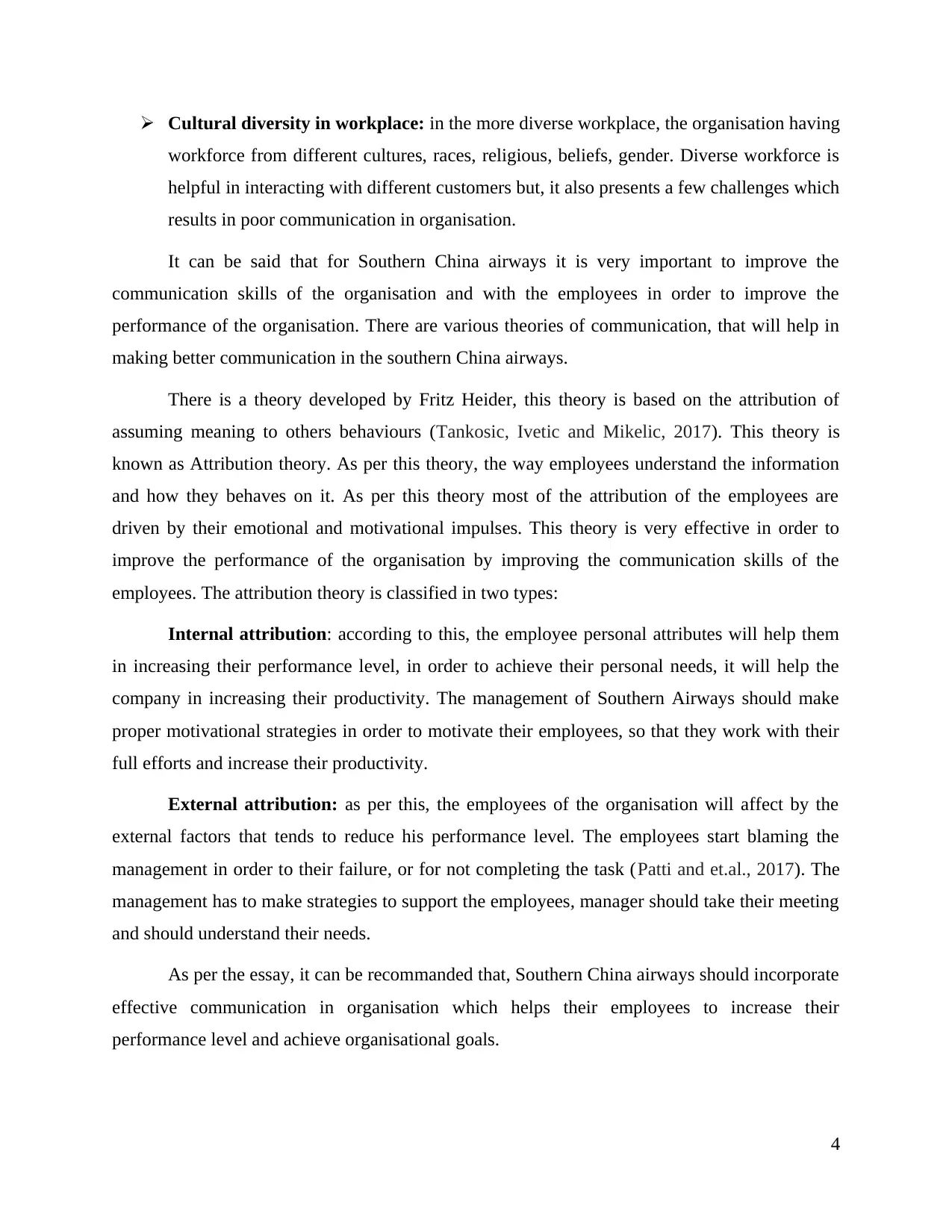
Cultural diversity in workplace: in the more diverse workplace, the organisation having
workforce from different cultures, races, religious, beliefs, gender. Diverse workforce is
helpful in interacting with different customers but, it also presents a few challenges which
results in poor communication in organisation.
It can be said that for Southern China airways it is very important to improve the
communication skills of the organisation and with the employees in order to improve the
performance of the organisation. There are various theories of communication, that will help in
making better communication in the southern China airways.
There is a theory developed by Fritz Heider, this theory is based on the attribution of
assuming meaning to others behaviours (Tankosic, Ivetic and Mikelic, 2017). This theory is
known as Attribution theory. As per this theory, the way employees understand the information
and how they behaves on it. As per this theory most of the attribution of the employees are
driven by their emotional and motivational impulses. This theory is very effective in order to
improve the performance of the organisation by improving the communication skills of the
employees. The attribution theory is classified in two types:
Internal attribution: according to this, the employee personal attributes will help them
in increasing their performance level, in order to achieve their personal needs, it will help the
company in increasing their productivity. The management of Southern Airways should make
proper motivational strategies in order to motivate their employees, so that they work with their
full efforts and increase their productivity.
External attribution: as per this, the employees of the organisation will affect by the
external factors that tends to reduce his performance level. The employees start blaming the
management in order to their failure, or for not completing the task (Patti and et.al., 2017). The
management has to make strategies to support the employees, manager should take their meeting
and should understand their needs.
As per the essay, it can be recommanded that, Southern China airways should incorporate
effective communication in organisation which helps their employees to increase their
performance level and achieve organisational goals.
4
workforce from different cultures, races, religious, beliefs, gender. Diverse workforce is
helpful in interacting with different customers but, it also presents a few challenges which
results in poor communication in organisation.
It can be said that for Southern China airways it is very important to improve the
communication skills of the organisation and with the employees in order to improve the
performance of the organisation. There are various theories of communication, that will help in
making better communication in the southern China airways.
There is a theory developed by Fritz Heider, this theory is based on the attribution of
assuming meaning to others behaviours (Tankosic, Ivetic and Mikelic, 2017). This theory is
known as Attribution theory. As per this theory, the way employees understand the information
and how they behaves on it. As per this theory most of the attribution of the employees are
driven by their emotional and motivational impulses. This theory is very effective in order to
improve the performance of the organisation by improving the communication skills of the
employees. The attribution theory is classified in two types:
Internal attribution: according to this, the employee personal attributes will help them
in increasing their performance level, in order to achieve their personal needs, it will help the
company in increasing their productivity. The management of Southern Airways should make
proper motivational strategies in order to motivate their employees, so that they work with their
full efforts and increase their productivity.
External attribution: as per this, the employees of the organisation will affect by the
external factors that tends to reduce his performance level. The employees start blaming the
management in order to their failure, or for not completing the task (Patti and et.al., 2017). The
management has to make strategies to support the employees, manager should take their meeting
and should understand their needs.
As per the essay, it can be recommanded that, Southern China airways should incorporate
effective communication in organisation which helps their employees to increase their
performance level and achieve organisational goals.
4
⊘ This is a preview!⊘
Do you want full access?
Subscribe today to unlock all pages.

Trusted by 1+ million students worldwide

5
Paraphrase This Document
Need a fresh take? Get an instant paraphrase of this document with our AI Paraphraser
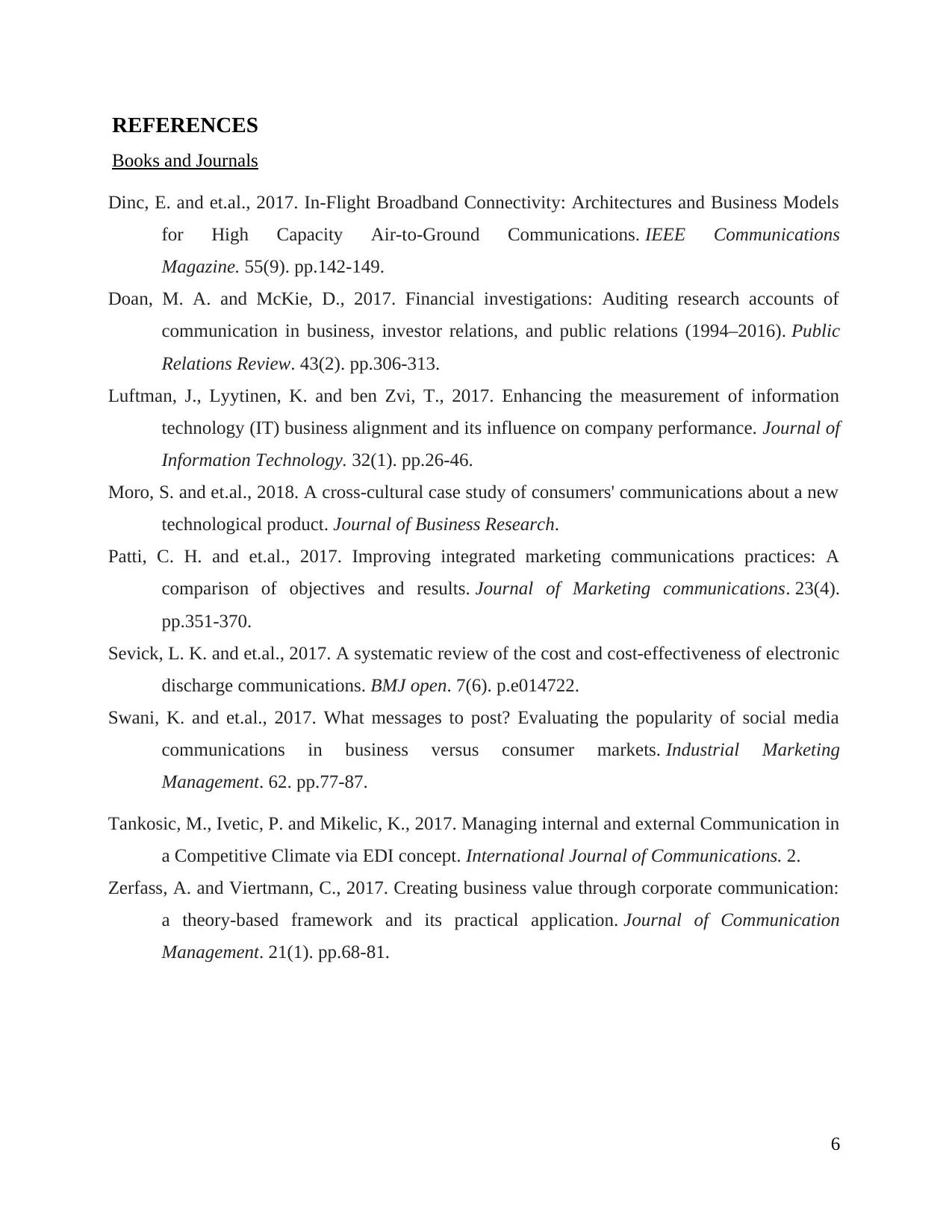
REFERENCES
Books and Journals
Dinc, E. and et.al., 2017. In-Flight Broadband Connectivity: Architectures and Business Models
for High Capacity Air-to-Ground Communications. IEEE Communications
Magazine. 55(9). pp.142-149.
Doan, M. A. and McKie, D., 2017. Financial investigations: Auditing research accounts of
communication in business, investor relations, and public relations (1994–2016). Public
Relations Review. 43(2). pp.306-313.
Luftman, J., Lyytinen, K. and ben Zvi, T., 2017. Enhancing the measurement of information
technology (IT) business alignment and its influence on company performance. Journal of
Information Technology. 32(1). pp.26-46.
Moro, S. and et.al., 2018. A cross-cultural case study of consumers' communications about a new
technological product. Journal of Business Research.
Patti, C. H. and et.al., 2017. Improving integrated marketing communications practices: A
comparison of objectives and results. Journal of Marketing communications. 23(4).
pp.351-370.
Sevick, L. K. and et.al., 2017. A systematic review of the cost and cost-effectiveness of electronic
discharge communications. BMJ open. 7(6). p.e014722.
Swani, K. and et.al., 2017. What messages to post? Evaluating the popularity of social media
communications in business versus consumer markets. Industrial Marketing
Management. 62. pp.77-87.
Tankosic, M., Ivetic, P. and Mikelic, K., 2017. Managing internal and external Communication in
a Competitive Climate via EDI concept. International Journal of Communications. 2.
Zerfass, A. and Viertmann, C., 2017. Creating business value through corporate communication:
a theory-based framework and its practical application. Journal of Communication
Management. 21(1). pp.68-81.
6
Books and Journals
Dinc, E. and et.al., 2017. In-Flight Broadband Connectivity: Architectures and Business Models
for High Capacity Air-to-Ground Communications. IEEE Communications
Magazine. 55(9). pp.142-149.
Doan, M. A. and McKie, D., 2017. Financial investigations: Auditing research accounts of
communication in business, investor relations, and public relations (1994–2016). Public
Relations Review. 43(2). pp.306-313.
Luftman, J., Lyytinen, K. and ben Zvi, T., 2017. Enhancing the measurement of information
technology (IT) business alignment and its influence on company performance. Journal of
Information Technology. 32(1). pp.26-46.
Moro, S. and et.al., 2018. A cross-cultural case study of consumers' communications about a new
technological product. Journal of Business Research.
Patti, C. H. and et.al., 2017. Improving integrated marketing communications practices: A
comparison of objectives and results. Journal of Marketing communications. 23(4).
pp.351-370.
Sevick, L. K. and et.al., 2017. A systematic review of the cost and cost-effectiveness of electronic
discharge communications. BMJ open. 7(6). p.e014722.
Swani, K. and et.al., 2017. What messages to post? Evaluating the popularity of social media
communications in business versus consumer markets. Industrial Marketing
Management. 62. pp.77-87.
Tankosic, M., Ivetic, P. and Mikelic, K., 2017. Managing internal and external Communication in
a Competitive Climate via EDI concept. International Journal of Communications. 2.
Zerfass, A. and Viertmann, C., 2017. Creating business value through corporate communication:
a theory-based framework and its practical application. Journal of Communication
Management. 21(1). pp.68-81.
6
1 out of 8
Related Documents
Your All-in-One AI-Powered Toolkit for Academic Success.
+13062052269
info@desklib.com
Available 24*7 on WhatsApp / Email
![[object Object]](/_next/static/media/star-bottom.7253800d.svg)
Unlock your academic potential
Copyright © 2020–2025 A2Z Services. All Rights Reserved. Developed and managed by ZUCOL.



